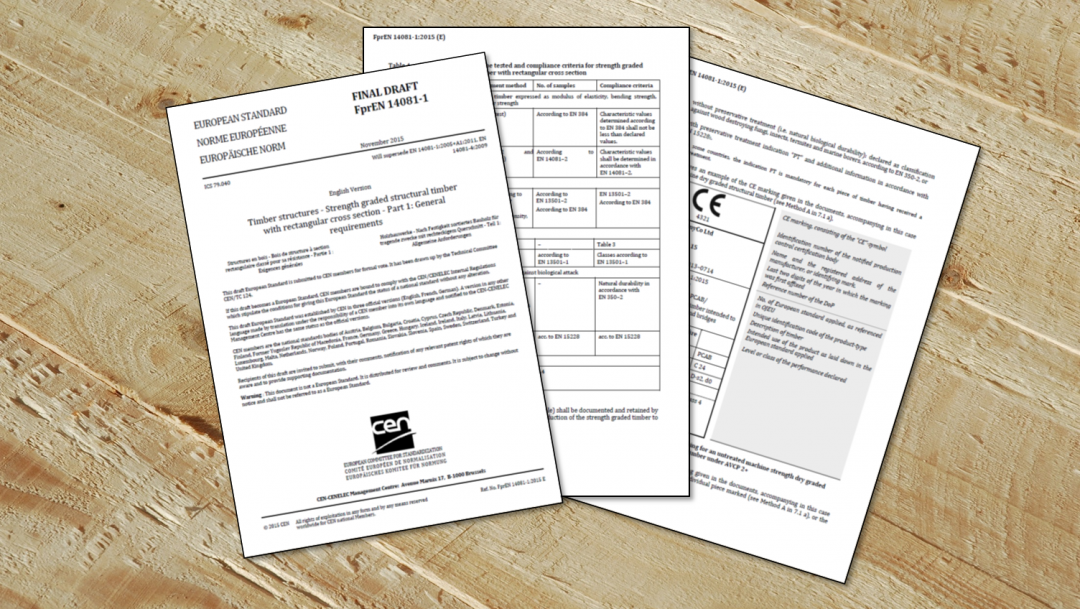
…or why you should not buy EN 14081-1:2016.
As we have discussed before (here and here), Harmonized Standards have a special status in that they are linked to EU legislation.
The European Standards (ENs) are created by one of the three European Standardization Organizations (e.g CEN, European Committee for Standardization) – which are separate from the EU – and then published by National Standards Bodies (such as the British Standards Institute). All standards are, in principle, voluntary – but they may be a way of demonstrating compliance with requirements that are not voluntary (1).
The Harmonised Standards (such as EN 14081 for structural timber) are different from regular ENs in the sense that they have a different trigger (EU legislation – in this case the Construction Products Regulation) and an extra acceptance procedure that results in them being cited in the Official Journal of the European Union (OJEU).
When a new EN is published, member National Standards Bodies are obliged to publish it and withdraw the previous version – but until that new version is cited in the Official Journal of the European Union it does not have proper status as a harmonized Standard. Until recently this has gone relatively smoothly – but something clearly went wrong, because we currently have some 80 or so Harmonized Standards that are not yet cited in the OJEU – and EN 14081:2016 is one of them.
What does this mean? Well it means (we think) that EN 14081:2016 cannot yet be used as the Harmonized Standard and structural timber should be produced according to the previous version, EN 14081:2005+A1:2011. British Standards Institute withdrew that on 31 May 2016.
The reasons why EN 14081:2016 is not yet cited are currently unclear – but the CEN committee concerned (TC124 WG2) hopes that they are not significant and can be addressed with an amendment (2). In summary: do not buy EN 14081:2016 – wait until there is an amended version that can actually be used.
There also seems to be a problem with EN 338:2016, which introduced some new strength classes (grades). In other standards, the classes are things that must be achieved – but for structural timber they are just a convenient way of stating performance. EN 338 is not, itself, a Harmonized Standard, but it is referenced by EN 14081, which is. The problem seems to be that new classes appear to the EC to be restrictions (and hence a barrier to trade) when in fact they actually make trade easier. It appears as though a Delegated Act is required to create new classes – although this should really only be the case where those classes are regulatory requirements…because otherwise we seem to put at risk special grades (like TR26) and user defined grades…and that would result in a barrier to trade. We will see what happens next year…
And what else? Well, earlier this year there was a case before the Court of Justice of the European Union (James Elliott Construction Ltd v Irish Asphalt Limited) for a dispute originating in 2005. We will leave understanding that as “an exercise for the reader” (3) but it seems to lead towards the conclusion that since Harmonized Standards are connected to European law, they are not purely private acts – and that since they have the effect of granting the right to free movement to companies complying with standards they can be regarded as legal acts. This calls into doubt the idea that standards (even Harmonized Standards) are voluntary…and makes us wonder if it is OK that you need to buy standards if they are themselves, somehow part of law.
1) More specifically, European law sets the “essential requirements” which manufacturers have to meet (whether they are using the harmonized standards or not) to ensure free circulation of their products on the Single Market. And (in this case) CEN develops voluntary standards that give technical solutions, accepted by the relevant industry, to ensure compliance with those essential requirements.
2) The intention is to have a meeting with representatives of the European Commission, CEN and TC124 WG2 to find out what needs to be done. No date is yet fixed.
3) In other words, too complicated for us to interpret.

Leave a Reply
You must be logged in to post a comment.